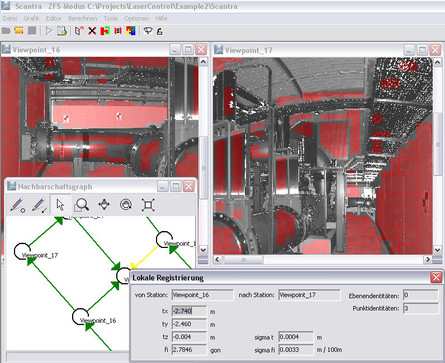Scantra works by automatically detecting and matching planes
FELLBACH, Germany – Placing targets in the field before scanning takes time, but it’s generally agreed – even with new automatic registration algorithms coming into many software packages – the practice is necessary for ideal accuracy post-registration. However, it’s also generally agreed that laser scanning interrupts work in occupied areas, and in some areas, like nuclear facilities, the less time spent there the better.
So, in an effort to speed up the scanning process, Techscan GmbH head Ulrich Schreyer worked in tandem with software developer Technet GmbH to create Scantra, a new piece of software that combines target-based registration with automatic plane detection and matching so that far fewer targets are needed for the same level of accuracy (or, in fact, greater accuracy, according to its creators).
“We’ve found you can save about 20 to 25 percent less time in the plant environment,” said Schreyer, who has been running his laser-scanning service since 2004. The back office time is about the same. After scanning, the raw scan files are imported into Scantra, processed, and then fed back into your point cloud processing software of choice.
“And in addition to the time you spend outside, you also gain great accuracy,” he said. “You’re not just matching scans with nine or 10 targets; you’re matching with thousands of planes, so you gain accuracy.”
In a 10-million-point data set with nine scan stations for which Screyer demonstrated the Scantra product for this reporter via Skype, he showed standard deviations as good as .4 millimeters with most points under 1 millimeter.
Currently, Z+F is selling Scantra alongside its LaserControl software, but Schreyer said, “it’s fully integrated into Z+F, but also stand alone.”
Schreyer has been working with Z+F for a long time, having purchased the first 5006 Imager from Z+F and using their scanners for his day-to-day work, and so it made sense that he would develop something to work seamlessly with LaserControl.
“At the moment, without reading the natural files of the other scanners,” he said, “we import ASCI, but we want Scantra to work the same with other scanners as it does with Z+F. We are interested in working with the other scanner manufacturers.” He also said working with the E57 standard is in the near-future plans.
For now, however, the product remains brand-new. It debuted at the recent Intergeo conference in Hanover, Germany, and a demo version will be available for download Oct. 25.
Schreyer believes the product could help those working in the plant and process industry, like him, but feels it also could have applications in situations like forensic scanning, where it might not be desirable to place targets in the scene. “And we will see next week with our demo version what comes out of that,” he said.






